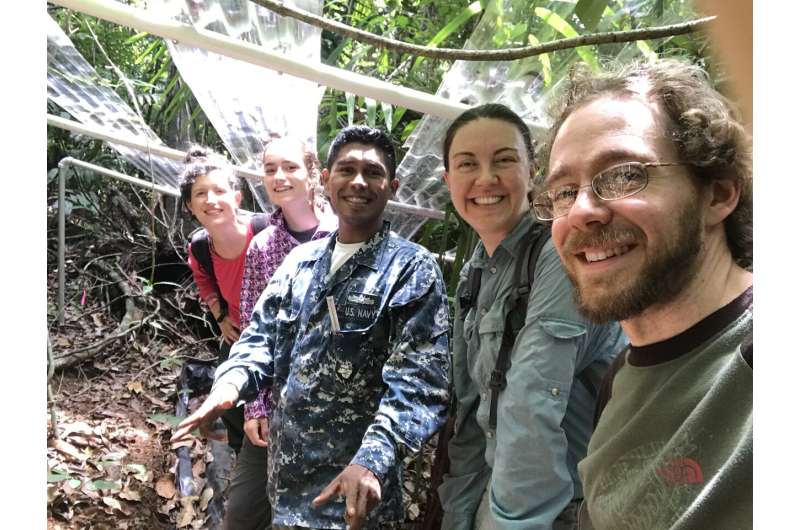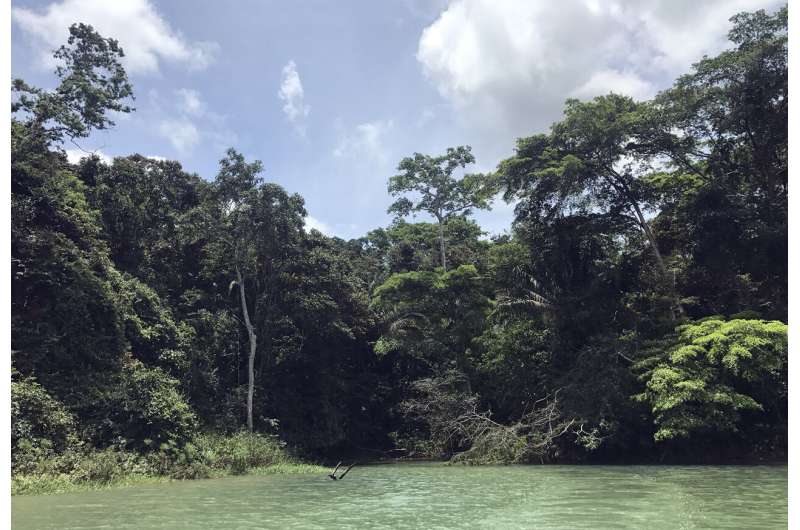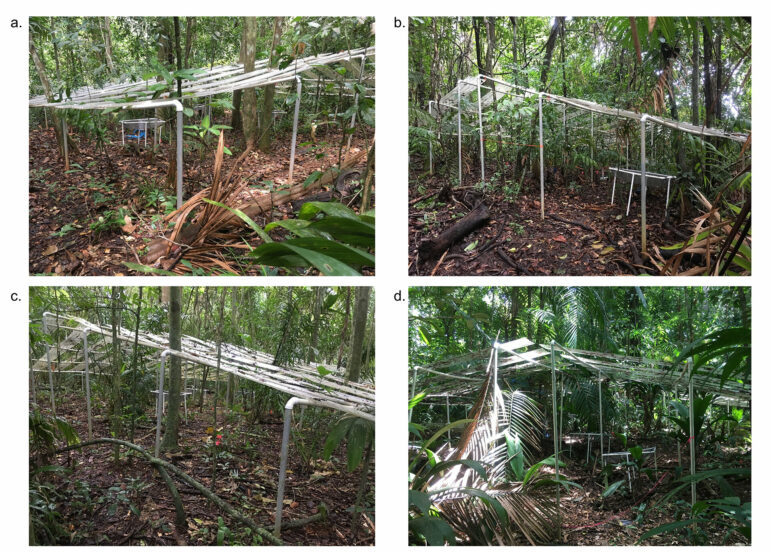Tropical rainforests store 25%-40% of global soil carbon, though they occupy only 7% of Earth’s land area. By functioning as a carbon sink, tropical forests prevent more severe effects from climate change.
A research team led by a Colorado State University scientist found that climate change will impact tropical forests’ ability to store carbon. Their study reveals that persistent drying in tropical forests, an anticipated result of climate change, leads to carbon loss from the most fertile soils—and that soil nutrients play an important role in how much carbon is released and when.
“Tropical forests can be really sensitive to reductions in rainfall,” said Daniela Cusack, lead author and an associate professor in the Department of Ecosystem Science and Sustainability, “and they have some of the largest stores of carbon on Earth. As climate is drying, that carbon is vulnerable.”
Climate change is reducing rainfall in some places and causing more year-to-year variation. Some tropical forests already have been documented as drying.
“All of that carbon that’s stored in rainforests right now is like a bank,” Cusack said. “We’re banking all that carbon and anything that releases that carbon is going to exacerbate climate change and impact everybody.”
Unexpected results
Cusack and her team assessed the effects of natural seasonal drying and chronic reduced rainfall on carbon fluxes in tropical forests. They found that natural seasonal drying suppressed the release of carbon dioxide.
“There was some resilience at first, which makes sense because these are seasonal forests, so they’re used to a dry season,” Cusack said. “But it seems like after that initial resilience, we’re hitting a threshold where things are shifting more rapidly in some tropical forests.”
The ecosystem model they used in the study predicted that persistent drying would increase the release of carbon dioxide from more fertile and wetter tropical forests but decrease CO2 fluxes from drier tropical forests.
“We had predicted that the wettest site would be most sensitive to drying,” Cusack said. “It’s the least adapted to drier conditions.”

PARCHED study field team, from left: Amanda Cordeiro (CSU grad student), Jackie Reu (intern), Edwin Garcia (Panama technician), Daniela Cusack (CSU professor and lead author) and Lee Dietterich (CSU postdoc and co-author). © Daniela Cusack
The expectation was that as the wetter sites dried down a little, they would become more favorable for microbes, which decompose carbon in soil, turning it back into carbon dioxide.
“What we saw was the opposite of what’s been hypothesized for these tropical forests,” Cusack said. The site they expected to have the biggest carbon loss actually lost the least carbon.
Perhaps the microbes can’t thrive in infertile soil, Cusack said, or maybe microbial activity is just slower to ramp up in the wettest soils because they take longer to dry out. Cusack said more research is needed to determine why the results disagreed with the model.
Carbon loss via respiration did increase significantly with persistent drying in the more fertile soils, suggesting nutrients play an important role in CO2 fluxes.
Withholding rain from the rainforest
The study, called PARCHED for PAnama Rainforest CHanges with Experimental Drying, measured the effects of natural seasonal drying and experimental chronic drying on soil carbon storage in four distinct tropical forests in Panama.
The forests encompassed a broad range in natural rainfall and soil fertility. This allowed the researchers to compare how different kinds of tropical forests would respond to drying.
With initial investment from the National Science Foundation, they took two years of baseline measurements, starting in 2015. Then the team started monitoring carbon fluxes under conditions imposed by experimental drying over plots of rainforest in 2018, thanks to funding from the Department of Energy.
To induce artificial drying, the team built partial greenhouse roofing over plots measuring 10 meters by 10 meters in each of the four forests. The roofing, which was below the forest canopy, diverted about half of the rainfall from the soil at each site. Trenches lined with plastic kept moisture from seeping into the study plots.
The study, published in Global Biogeochemical Cycles, showed that different tropical forests will respond to climate change differently and on different time frames, and that fertile soils may be the first to react with big carbon losses across the tropics.

View of one of the rainforests studied by CSU researcher Daniela Cusack, as seen from a motorboat on the Panama Canal. Researchers had to access the forests in the study by boat. © Daniela Cusack
Researchers were surprised that soil nutrients seem to have as big an effect as soil moisture, which necessitates updates to predictive models.
“If there aren’t enough nutrients, the microbes don’t seem to respond as much to changes in moisture,” Cusack said.
Scientists have not observed changes in plant growth or conversion of CO2 to oxygen via photosynthesis yet, which makes sense, Cusack said, because plants are bigger organisms that take longer to grow.
“Microbes are small creatures, and they tend to respond much more quickly to climate change and other kinds of disturbance,” she said.
With continued experimental drying, the other plots also are trending toward carbon loss, Cusack said—one more reason to address emissions problems and increase carbon sequestration initiatives.
“Everyone thinks about temperature change, but I think precipitation change can be more confusing,” Cusack said. “It’s more variable, and it’s changing differently in different places. But drying in the tropics is a real concern as far as these carbon stores.”
Improved prediction
Cusack and her team’s results have contributed to improved modeling of rainforest carbon cycling.
Ecosystem-scale soil carbon models were developed for temperate forests, which is why they don’t simulate saturated, infertile tropical soils very well. The researchers updated the carbon model they worked with to better match their observations.
Soil fertility is not fully represented in many ecosystem carbon models, especially for the nutrients scarcest in tropical forests, like phosphorus. In many existing soil carbon models, carbon loss predictions are based primarily on soil moisture. Cusack said representing nutrients better in ecological models is an important next step in this research.
Authors of the study, “Soil Respiration Responses to Throughfall Exclusion are Decoupled from Changes in Soil Moisture for Four Tropical Forests, Suggesting Processes for Ecosystem Models,” are Cusack, Lee H. Dietterich, with CSU’s Department of Ecosystem Science and Sustainability, and Benjamin N. Sulman, with Oak Ridge National Laboratory. The Department of Ecosystem Science and Sustainability is part of the Warner College of Natural Resources.
More information:
Daniela F. Cusack et al, Soil Respiration Responses to Throughfall Exclusion Are Decoupled From Changes in Soil Moisture for Four Tropical Forests, Suggesting Processes for Ecosystem Models, Global Biogeochemical Cycles (2023). DOI: 10.1029/2022GB007473
Provided by
Colorado State University
Citation:
Scientists trying to determine what will happen to massive carbon stores as rainforests dry out (2023, April 17)



